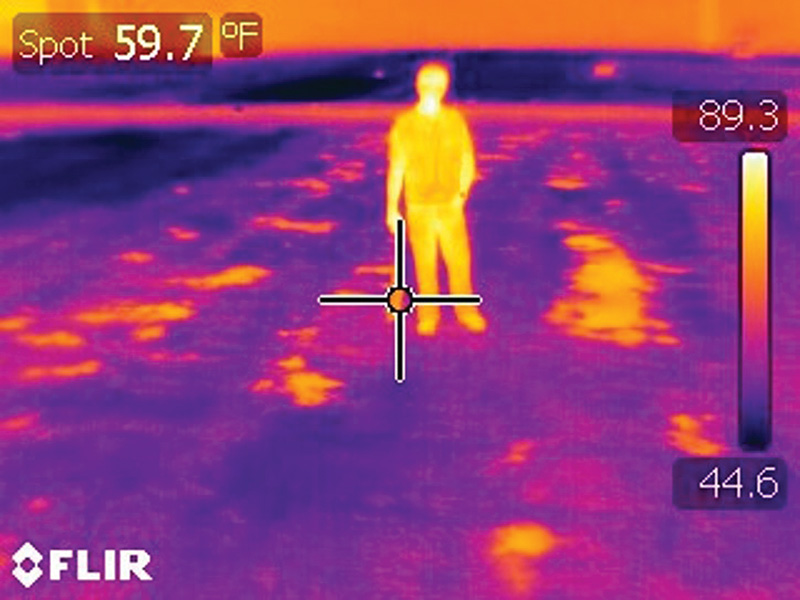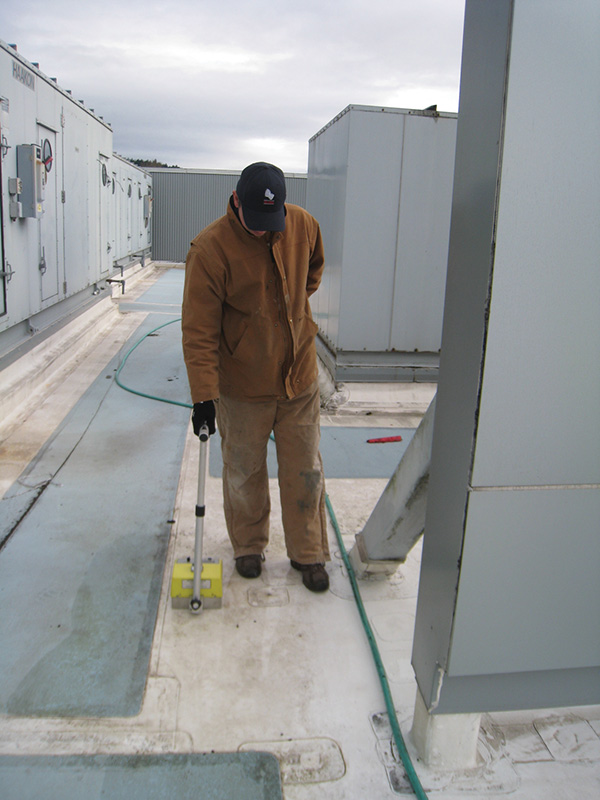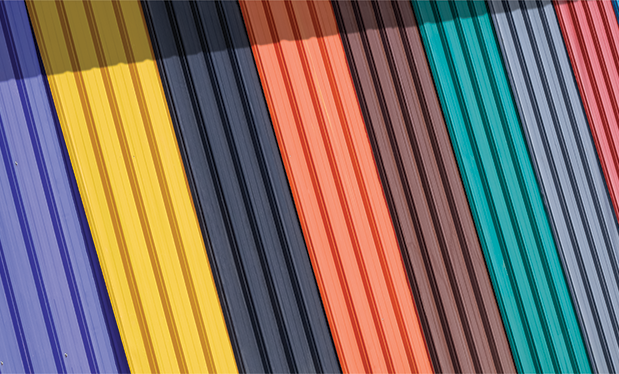
A moisture survey of a low-slope roof system is simple in concept—you locate and mark wet areas on a roof. Because current industry guidelines, building codes and common good roofing practice require a moisture-laden roof not be recovered, moisture surveys often are conducted. On some occasions, there is so much moisture no reasonable person would argue a particular area of roof is not wet. But a problem arises when a roof system or areas of a roof system are not fully saturated and liquid water is not clearly present. Then, a debate occurs about the best method to detect the moisture and what amount of moisture is too much.
Currently, there are three commonly used methods for moisture detection in low-slope roof systems: infrared imaging, impedance meters and nuclear roof scans. All the methods have been on the market for decades. But lately, these options are proving less successful with some newer roof system installations and materials.
Infrared imaging
Water has one of the highest abilities to store heat energy in nature. During the day, the parts of a roof that have higher moisture content absorb and hold heat energy imparted by the sun. During the night, the moisture-laden parts of the roof that stored heat energy are warmer and, therefore, emit more infrared energy than “dry” roof areas. An infrared imager “sees” this energy being radiated out and allows you to identify the areas of higher moisture content.

The ability to locate moisture must not be confused with the ability to determine how much moisture exists. Many roofing professionals have tried to assert they know how much moisture is present in a roof system by its infrared energy emission (temperature). These assertions do not stand up to scrutiny. They could be accurate in a controlled laboratory environment but not on a roof installed outdoors in the real world.
An infrared scan can accurately locate moisture within inches. When the areas that emit more energy are located, they are referred to as thermal anomalies because the infrared imaging doesn’t show what caused temperature variance. It could mean there is elevated moisture content in a roof system or a reflection of heat energy off a roof membrane. Even a simple collection of dirt or loose roof granules can hold heat into the night and create a thermal anomaly that looks identical to roof insulation with high moisture content. Therefore, anomalies are marked on the rooftop and then need to be confirmed later as roofing material with elevated moisture content.
Infrared scans for low-slope roof systems began in the 1980s. The apparatus used at the time required two or three people to handle the equipment and the liquid nitrogen needed to cool the infrared sensor inside the imager.
Currently, many infrared scans are done with aerial drones using infrared imagers that can fit into the palm of one’s hand. Drones are much faster than humans but can be less accurate because a drone can only record images from a distance and cannot mark thermal anomalies, opposed to a person creating a map by hand and marking a roof membrane where thermal anomalies are found.
Infrared imaging has other disadvantages. One of the largest issues is it needs suitable weather to impart solar energy into moisture-laden roofing materials. Cold air, rain, snow and clouds can prevent sufficient solar energy from reaching a roof for an infrared imager to be able to differentiate dry versus wet roof areas. Infrared scans also are not able to detect moisture in a roof system with thick insulation layers. This is particularly true of moisture deep in a roof assembly with thick insulation when upper parts of the roof system are relatively dry.
Impedance meters
Impedance meters create an electric field between two pads on the bottom of the meter. When the meter is placed on a roof’s surface, the resulting impedance creates a reading on the meter. The higher the moisture content, the lower the electrical resistance of the material and, subsequently, the impedance.
The measurement of moisture content as a percentage of saturation can be done accurately with impedance meters if the meter is calibrated to the material. For example, most meters of this type are calibrated to dimensional framing lumber but not to different roofing materials such as single-ply membranes, polymer modified bitumen, polyisocyanurate, gypsum-based cover boards, etc. Therefore, the readings from an impedance meter used on a low-slope roof system must be used as a relative reading tool. A known dry area of a roof system may read 0 on the 0-100 relative scale, and a known saturated roof area may read 100. Obviously, moisture content falling between these will read between 0-100.
When placed on a roof, impedance meters can accurately pinpoint the location of moisture to fractions of an inch, but they cannot locate the depth of the moisture. Different impedance meters have different power levels; typically, the larger the unit, the stronger the electric field it generates. Therefore, different meters can detect moisture at different depths in a roof system. But they cannot tell you whether moisture is in the cover board or deep down in the roof deck, for example.
Impedance meters give instantaneous readings. They do not damage roofs in any way and can be used at most reasonable air temperatures. However, the roof surface must be free of moisture when taking a reading otherwise the two pads on the meter will be electrically shorted out by the moisture.
Impedance meters cannot be used on conductive roof membranes, such as EPDM; metal; or roofs with aluminized coatings. In addition, metal fasteners, insulation plates and lead flashings near drains can give false positive readings. Even metallic conduit and pipes that have been embedded in a low-slope roof system can cause electrical short circuits and give false readings. A bit of experience and common sense is needed to use these instruments effectively.
Recently, two new culprits have been misleading impedance meter operators. The first is metal mesh embedded in roof systems as part of some electronic leak-detection systems. The second is conductive primers used with other electronic leak-detection systems. Both include conductive components inside roof assemblies that can cause a short circuit with an impedance meter.
Nuclear roof scans
Nuclear roof scans are one of the oldest techniques available to the roofing industry. The process was invented by the U.S. government many decades ago but diminished in use at the turn of the century because of regulations by the U.S. Nuclear Regulatory Commission and insurance and paperwork requirements. However, nuclear scans have seen a resurgence of late.

As the name implies, the method involves a nuclear source of high-energy neutrons such as Americium-241, Radium-226 or Cesium-137. The neutrons are emitted by the radioactive source and directed into the roof system. Upon impact, the neutrons backscatter because of the high amount of hydrogen contained in water. The more water present, the more backscatter occurs.
The nuclear unit has an emitter and a detector built into one box. The operator places the unit over a spot on a roof and lets the unit sit for 15 seconds to four minutes depending on the accuracy desired. The detector counts the backscatter and reports the number of detections. The unit can scan only one spot at a time. As part of the process, a roof will be overlaid with a square grid, typically 10 feet by 10 feet. The operator places the detector at a grid line intersection, waits for the nuclear gauge to provide a count, records the count and moves to the next grid point.
This method of moisture detection is by far the slowest of the methods. With large roofs, it can take many days for a technician to visit every grid point. The technician eventually has a long list of counts from the meter and then must conduct a statistical analysis of the data and plot the data on a roof map. The count data by itself is of little value. The technician also must take roof samples and perform additional analysis on them to correlate count numbers to moisture content.
Nuclear scans have the lowest resolution of any of the moisture survey methods because the readings are taken at a specific point on a grid and not continuously. Therefore, small moisture-laden areas between grid points can be missed. The grid size can be reduced, and many times it is. However, this dramatically increases the number of stops a technician needs to make, increasing time and labor cost.
Nuclear scans have several advantages. They are somewhat impervious to poor weather. Even a thin film of moisture, such as dew or frost, can be dealt with by an experienced technician. Nuclear scans also can read through conductive materials such as metal, EPDM and conductive coatings. Additionally, the issues with conductive primers and metal leak-detection grids do not impede nuclear scans.
Gravimetric analysis
Gravimetric analysis is not explicitly used as a moisture survey technique. However, it can be combined, and many times is, with the previously discussed moisture survey methods. Gravimetric moisture analysis involves taking a roof sample and drying it in a laboratory convection oven. The mass is measured before and after the sample is dried in the oven and is used to calculate the moisture content percentage of the material at the time of extraction.
Different materials can hold different amounts of moisture. Some materials can greatly exceed 100% moisture content by weight. For example, common roof insulation materials can contain more than 100% moisture content by weight and still technically not be considered wet. Furthermore, polyisocyanurate insulation products have attached facers that can and will have a much different tolerance for moisture content than the foam core. Coated fiberglass mat facers will store little moisture and not be degraded by moisture presence. Conversely, fiberglass-reinforced felt (paper) facers readily absorb moisture and experience strength loss as a result.
Of all the methods for moisture survey and measurement, gravimetric analysis is considered the most accurate. However, this method only gives the moisture content from where the sample was taken. Therefore, it is best used in combination with another method. The only major caution is in the selection of the drying temperature. Lower temperatures demand longer oven times for drying but tend to be more conservative in treatment of the sample in the oven. However, too high a temperature can damage some materials.
An example would be drying a gypsum-based cover board at too high a temperature and causing calcination where the water molecules chemically bound to the gypsum are driven off. This chemically bound water is present in addition to the free moisture that is of actual interest. In this scenario, selecting a temperature that is too high can lead to inaccurate gravimetric results. As such, an experienced technician should conduct gravimetric work.
Concerns
Lately, there have been issues with improper moisture surveys being conducted on new roofs. Several of the problems were already identified but are worth repeating because of their importance:
- Metal leak-detection mesh or conductive primers in roof systems. When these conductive components are present in a roof, they may trigger false positive readings during a moisture detection survey using an impedance meter. The technician conducting a moisture survey must be more cognizant than ever of what a roof system is composed of before relying on moisture readings and reporting them.
- High-density polyisocyanurate cover boards are not absorbing moisture and concealing moisture from moisture surveys. The high-density and closed-cell nature of polyisocyanurate cover boards is, in some cases, concealing moisture contained below from impedance, infrared and even nuclear meters. Be extra cautious of moisture survey readings conducted over high-density polyisocyanurate cover boards. I recommend taking test cuts and/or roof cores with these systems to confirm readings with direct moisture meter readings of the material layers and/or gravimetric analysis of the roof assembly core sample.
- Voluminous depths of insulation. In many jurisdictions, energy codes are driving roof installations characterized by significant thickness of insulation that can conceal moisture from moisture survey equipment. The moisture is too deep to alter the surface temperature for infrared readings, and the other methods do not penetrate deep enough to read more than perhaps 6-12 inches below the roof surface. Therefore, moisture that has migrated beyond these depths may not be detected.
- Fiberglass-reinforced felt (paper) facers on polyisocyanurate insulation. These facers are susceptible to strength loss with even slightly elevated moisture content. Care must be taken when doing moisture surveys involving these insulation boards to identify where in the roof assembly cross-section the moisture was detected. If moisture has accumulated at or near the insulation facers in the roof cross-section, further assessment of the roof’s condition is warranted.
- Irreversible moisture damage to gypsum-based cover boards. When gypsum-based cover boards encounter too much moisture, they structurally degrade. The exact amount of moisture needed to trigger this damage varies by product and product generation. But when gypsum-based cover boards are exposed to too much moisture, they physically lose their integrity and can no longer resist uplift forces in adhered roof systems. This condition commonly presents as a soft substrate under foot even if the cover board has dried versus the firm, solid substrate gypsum cover boards typically provide. The technician conducting the moisture survey must be cognizant of the change in the substrate quality (even if the moisture meter indicates no moisture) and investigate or, at a minimum, make note of the issue.
Guidelines
The following standards can provide more information about moisture surveys:
- ASTM C1153, “Standard Practice for Location of Wet Insulation in Roofing Systems Using Infrared Imaging”
- ASTM D7954, “Standard Practice for Moisture Surveying of Roofing and Waterproofing Systems Using Nondestructive Electrical Impedance Scanners”
- ANSI/SPRI/RCI NT-1, “Detection and Location of Latent Moisture in Building Roofing Systems by Nuclear Radioisotopic Thermalization”
How much is too much?
When a moisture survey and any resultant gravimetric measurements are made, how much moisture can a roof contain before it is considered wet? This is the ultimate question asked in many legal cases.
The closest answer the roofing industry has comes from the late Wayne Tobiasson, a noted researcher. He and his team proposed that for an insulating material to be considered wet and in need of replacement, it needed to have lost 20% of its thermal resistance (R-value). Therefore, the insulation would only have 80% of its thermal resistance remaining. This concept is commonly referred to as the R80 rule.
To give a point of reference as to how much moisture is required to reach this level, polyisocyanurate roof insulation would need to reach a moisture content of about 262% by weight to be at its R80 point.
The R80 rule is a reasonable concept. However, materials currently on the market, such as gypsum-based cover boards or fiberglass-reinforced felt (paper) facers on polyisocyanurate insulation, cannot remotely tolerate this level of moisture. Therefore, the R80 rule loses much of its relevance in practice but still gives the roofing industry perspective regarding moisture levels in low-slope roof systems.
Some roof consultants rely on a concept called equilibrium moisture content (EMC), which is the amount of moisture stored in a material after it has come to equilibrium with its surroundings (a particular combination of temperature—typically room temperature—and humidity).
Some individuals will look at a material’s moisture content and if it is above EMC at room temperature, consider the material wet. The problem lies in the reality that roofs exist in extreme cold and heat, high and low humidity, and everything in between. So EMC at room temperature may have little practical significance. Combine this with the wildly different effects moisture has on different roofing materials, and the EMC concept begins to lose traction. Use the concept with caution.
When and where to get help
Current industry guidelines, building codes and common good roofing practice require a roof re-cover not be placed over a moisture-laden roof. As a result, many roofing contractors are adding moisture surveys to their list of services.
But a simple review of the industry guidelines for the specific moisture survey type (see “Guidelines”) can help avoid many of the mistakes that have led to legal disputes based on improper or ill-advised moisture surveys.
If you have questions, consult the technical committees of your local, regional and/or national roofing contractor associations. These committees and association staff tend to be well-versed in moisture surveys and at a minimum will know who to contact for more exacting answers to your questions.
MATT DUPUIS, PH.D., P.E., is president of SRI Consultants, Waunakee, Wis.


